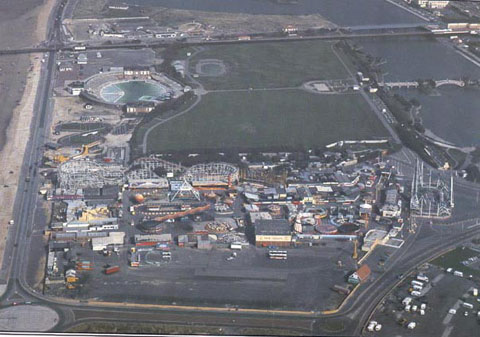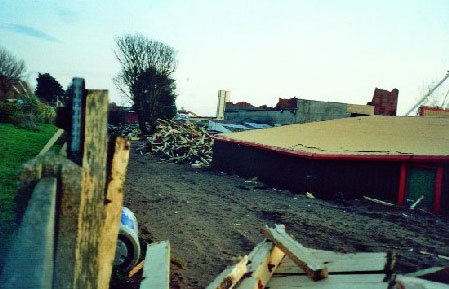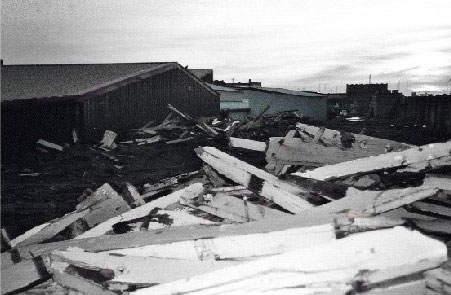|
|
|
| HOME ARTICLES GALLERIES ABOUT US FORUM LINKS CONTACT JOYLAND BOOKS | |
|
GOING, GOING, GONE: THE ORIGINAL SOUTHPORT PLEASURELAND (PAGE 7) by G Radice/H Booth/P Gould/P Grimshaw/R Houghton/D Jones/Kate/M Pavion Article: Added 2004 to 2007 |
|
|
English Heritage (Listing) Adviser's Report 20 September 2006 The Cyclone Roller Coaster at Southport Pleasureland,
MARINE DRIVE, SEFTON
Advice Comments/Reason for No Previous Listing:
Reason For Decision:
RECOMMENDATION CONTEXT: We have been asked to consider the Cyclone roller coaster at Southport Pleasureland Amusement Park for listing. The amusement park closed on the 5th September 2006 and demolition of the Cyclone roller coaster began shortly after this. This case has aroused considerable local interest and has involved the media. It has been given a deadline of 19th September due to the ongoing demolition. A request for access for a site visit was refused. HISTORY: The Cyclone roller coaster at Southport Pleasureland Amusement Park was designed by the distinguished Modernist architect Charles Paige with the roller coaster's station being designed by the American rollercoaster expert Joseph Emberton. It opened in 1937 and was the last of Paige's roller coasters to be built in the UK. Paige's method of construction allowed for the wooden roller coaster structure to be unbolted and removed to another location should the need ever arise. It formed a prominent feature at Pleasureland, Southport's noted amusement park that formerly opened in 1922. Earlier rides existed, however, and the Caterpillar ride was constructed in 1914. During the Second World War the amusement park was requisitioned by the War Office and subsequently closed between 1941-1944. The roller coaster, however, remained in situ throughout this period of closure and it opened again in 1944. At unspecified dates after the war the roller coaster was damaged and subsequently repaired on two occasions, firstly after a fire and secondly after adverse weather damaged the structure. Some alterations were also made to the roller coaster's station: one source states that the station's building and part of the rollercoaster were lost to fire in 1984 and rebuilt to the original design. In 1999 the site was acquired by Blackpool Pleasure Beach. The roller coaster closed on 5th September 2006 and demolition began a week later. DESCRIPTION: A roller coaster built in 1937 to a design by the American roller coaster expert Charles Paige with a station designed by Joseph Emberton. It is constructed of timber and was bolted together to allow for ease of repair and/or removal. The circuit formed a figure of 8 and the cars were propelled with the aid of undertrack friction wheels. Passengers were carried in two trains with three cars per train and were sat two across in three rows per car, giving a maximum capacity of 18 passengers per train. The ride length was 762m and it reached a height of 18.2m and a top speed of 42 mph (67.6kph). The station consisted of a low modernist kiosk with a tall pylon, originally with lettering reading "CYCLONE" along its height. The adjoining canopy sheltered customers who entered via a ramp to the cars. ASSESSMENT: Roller coasters developed out of ice slides and the first examples were wooden slides in Russia and France, but railways in the United States began to exploit the possibilities of scenic rides in the 1870s. The two ideas were brought together in a series of patents in the 1880s and in 1884 Thompson's Switchback Railway opened on Coney Island, with cars running at 6 mph (9.6 kph) on a wooden structure. There followed a craze for roller coasters and scenic railways, the latter with picturesque tableau until the demands for higher speeds and scarier rides won out. The earliest surviving roller coaster in England is a timber structure at Margate from 1920 and it is the only one listed. The interwar years saw the height of the Roller Coaster craze, and the Southport Cyclone stands at the end of a line of notable examples, few of which survive. Information from a roller coaster historian and planning advisor, Nick Laister, shows that just nine historic roller coasters survive in Britain. The Cyclone roller coaster at Southport was one of the last undertrack friction wheel wooden roller coasters to be built, being the designer Paige's final roller coaster constructed in this country. Southport's Pleasureland may lack the importance of Blackpool as an amusement park, but it was still a noted complex in its day. The employment of Joseph Emberton showed Pleasureland's desire to create highly fashionable structures. The designer of the noted Simpson's Shop in London Piccadilly, he also designed the casino and the structures at Blackpool in the later 1930s. His Grand National building at Blackpool Pleasure Beach of 1935 would have been very comparable to the Southport Cyclone: regrettably it was built in replica in 1990 and hence rejected for listing in 2001. The Cyclone at Morecambe of 1937 was demolished in 2000 and the category is clearly a vulnerable one. This example is significantly later than the listed Margate example, and lacks Group Value with other listed entertainment buildings. When viewed from the adjacent road on the evening of the 15th September the structure appeared relatively intact but some of the track had been removed. An attempted site visit on 18th September resulted in a refusal of access. When viewed from the adjacent road, workmen with chain saws and a crane could be seen actively demolishing the structure and a substantial piece of the roller coaster's south east end had been removed. The structure was recorded by English Heritage in 2002. CONCLUSION: Due to ongoing demolition and the significant rebuilding that took place after a fire in 1984 this roller coaster cannot be given a listing recommendation. |
|
|
|
|
|
THEMAGICEYE | Terms and Conditions | Privacy Policy | Contact Us |
|



